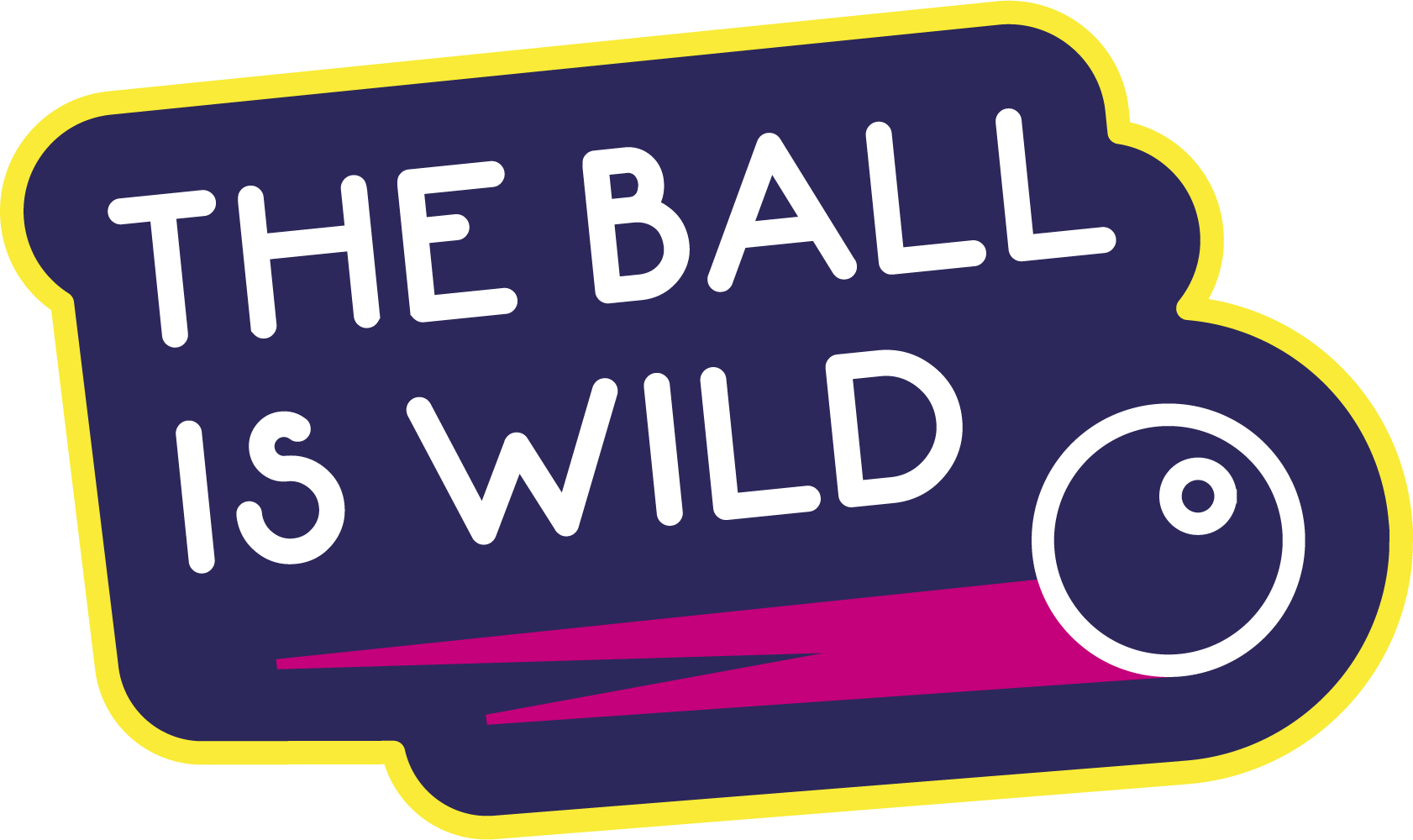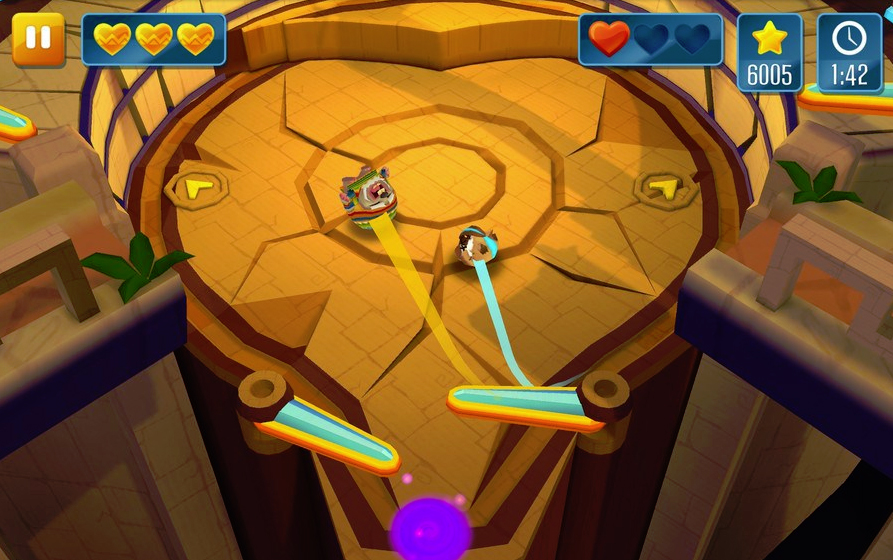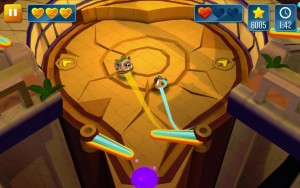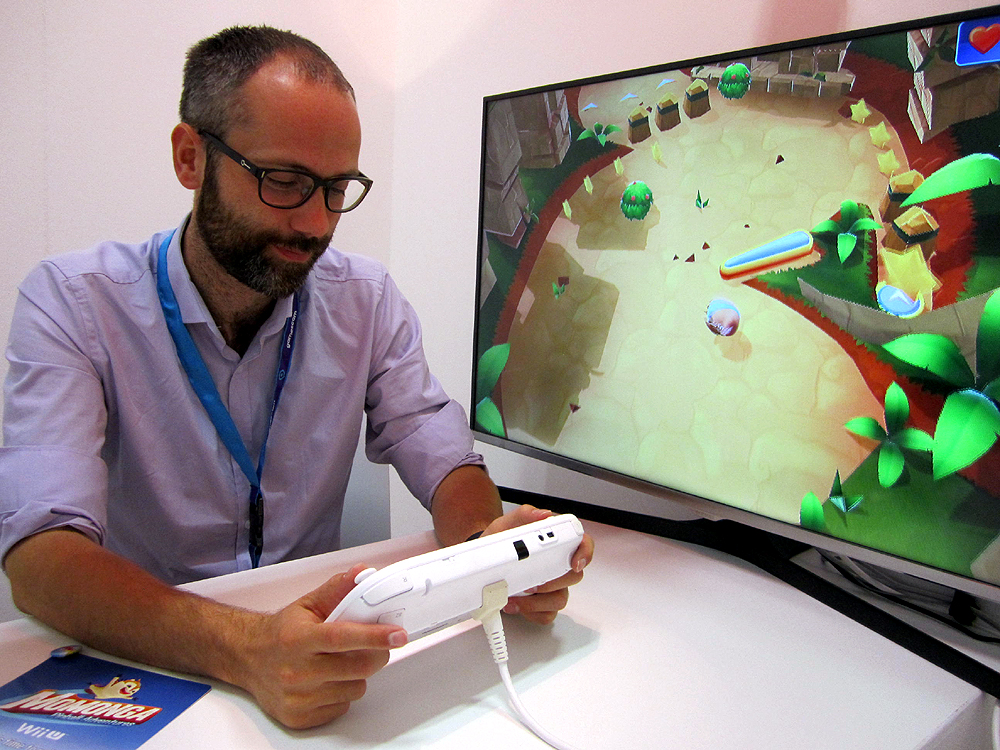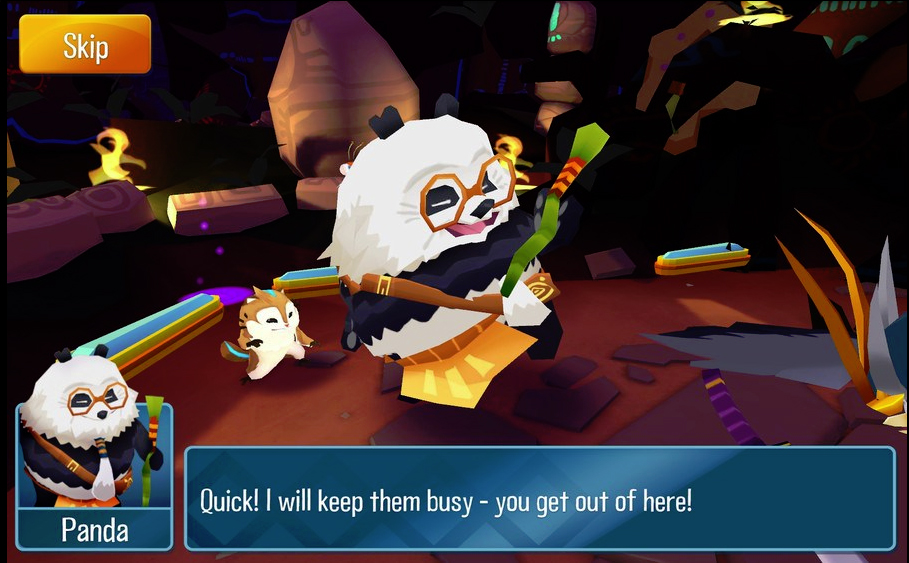I am always excited when a pinball videogame comes out that is not first and foremost a simulation of physical pinball but instead brings in a creative take on the established silverball formula. This works very well with videogames because they are not bound to physical limitations and restrictions. Video pins are nothing new of course. With titles like “Pin Pong” (1974) or “Gee Bee” (1978), they are almost as old as videogames themselves. These days though, the astonishing quality of recent video pinball games like the remake of “Pro Pinball: Timeshock!” or the “Zen Pinball” tables has made it very hard to come up with more casual, narrative driven pinball games that try to bring in some new ideas.
Still, some bold videogame studios are releasing their own pinball ideas in form of unconventional titles. One of them was “Rollers of the Realm” which came out in Summer of 2014. The Ball is Wild did a review on the game and also an interview with the Canadian developers from Phantom Compass.
It was about the same time when another video pinball game was already available: “Momonga Pinball Adventures” by Paladin Studios, a Dutch indie game company. “Momonga” tells the story of a cute cartoon character named Momo who lost his tribe to evil, brainwashed owls. On his adventure to find his people, he gets help of an old, wise panda and a kung-fu firefly which get’s in combat mode once a bell has been rung. As with “Rollers”, “Momonga” also features the character as the ball and levels with different areas and secrets instead of a fixed table as seen in regular pinball. “Momonga” is a mobile videogame (for iOS and Android devices), therefore the levels are a bit smaller as in “Rollers” but have different challenges in each of them. Also, in between the regular levels, there are score hunt stages, where Momo (a flying squirrel) spreads his wings and collects stars in the air. “Momonga Pinball Adventures” is a family friendly pick-up-and-play game which I really enjoyed playing. At Gamescom in Cologne this year, I was pleasantly surprised to hear that it will recently also be released for Wii U. On this occasion, The Ball is Wild talked to Derk de Geus, CEO and co-founder of Paladin Studios (since 2005) about endless pinball, narrative pinball games and why Japanese players usually have a hard time grasping the concept of the silver- – or in this case – Momoball.
What have been the most important milestones for Paladin Studios throughout the first ten years?
We started as two freelance programmers. When we had those early years, we were basically just a work for hire company. If people needed a technical solution for a challenging problem within game technology, then they could get it with us. Later we moved on to building training simulators, visualisation tools, anything with 3D game technology – but not games. But we were like a developer, we used a 3D engine called “Quest3D” before we switched over to Unity. And then we created all kinds of projects – except games themselves. People would hire us for creating architectural visulisations or training simulators. At some point we finally said: Okay, we want to make games, this is our passion. We need to take that energy and just go for it – or discontinue our company. So we tested the waters with a really small mobile game called “Jimmy Pataya”. We built it and launched it in two weeks – really compact, really small. And that was a success and it gave us the feeling of: Yeah, we can do this, we can actually make games and launch them and have a decent success as well. After that, we figured out what we want to do next. We had the idea of an endless pinball game where you go through different stages and you need to get as far as possible – pretty much like in an endless runner like “Temple Run” or “Subway Surfers” but with pinball. It was a very interesting idea, so we created a rough prototype and saw that the concept worked. From that point on, we said: Let’s do this, let’s really make this pinball game, and then, let’s also invest in it, so that it is a bigger game and has a higher chance of success. That was the beginning of “Momonga”. In the end, we dropped the endless part and added levels, added the storyline and characters. And after two years of on-and-off development as a side project, we launched “Momonga”. I think that this is actually the biggest milestone for us as a company because before that, we just did a lot of non-games. After “Momonga” – basically right now – all we do is games. We realized our dream that we want to focus on our passion and make games, and that’s great!
What made you choose pinball as a genre in the first place?
We had a challenge within the team to come up with crazy ideas. One of the ideas that came from a programmer, Eurik, was that of the endless pinball game. His reasoning and also the reason why we eventually went for the pinball genre, is that we felt that it was an interesting genre that was highly underrated by game developers in general. We also felt that there are a lot of pinball simulators out there but not so much innovation in that area in videogames. So we said: Okay, if we create something innovative in that genre – maybe it will stand out. The second reason was that pinball has (basically) two buttons. So it’s really suitable for multiple platforms – not just iOS but also consoles. PC is also possible, even smart TVs. Back then, we thought: Smart TVs are going to be big. We thought: Let’s make something that’s super multiplatform. We also just loved pinball games. Recently I checked an old pinball game that I played a lot when I was young. During every family party, we would sit down behind the TV an MSX and played this game that actually had several stages in it as well. And I recently played that and I figured: This actually looks a little bit like “Momonga” in the sense that you can basically drop down and progress through different stages, get higher and all that kind of stuff. It’s a completely different game, but still I have somehow – subliminaly, unconsciously – those childhood memories of pinball. And I guess they just made their way here.
Coming back to the idea of an endless pinball game. How would this have worked? The table is endless and you shoot up and up and up?
Yeah, that’s exactly what it is. It was a randomly generated table, so every time you would play, you would have a slightly different composition. And then you had to basically go up and get to the next checkpoints.
As you mentioned before, “Momonga” is not a simulation, it’s a casual pinball videogame. What target group do you want to address? A lot of pinball fans play video pinball, but they are very picky when it comes to the physics. Can you tell me more about the pinball physics of “Momonga”?
It was a tough one. I think we really underestimated the physics part. What we tried to achieve was finding a balance between a casual player who doesn’t know pinball very well and more advanced players. A lot of the tricks that are in pinball simulators don’t work in “Momonga”. Some of them do but not nearly all of them. The question for us was: What kind of experience do we want to have? And we went for the “as mainstream as possible” experience. If you need the special tricks to progress through the levels then that would not be a good thing for us because it’s supposed to be a simple game that anybody should be able to play – not just pinball veterans. And in that sense I think it’s a completely different approach because we use the flipper mechanic as a means of navigating through the level. Whereas with a regular pinball machine, you use it as a means of staying in the game and hitting specific targets and if you lose control over the ball, you are likely to lose. A lot of pinball machines are focussed around ball control and making sure that you stay in the game. In our case, this doesn’t really work. It’s a fine balance but I think we did a fairly good job with it. At least it’s very responsive – that was our primary concern. Some pinball simulators attempts out there are kind of slow: When you flip a flipper, it takes a couple of frames to get to the top. Or sometimes the ball control is pretty tough it terms of aiming. Responsiveness and aiming, those were the focus points for us.
The interesting similarity with “Momonga” and the other recent pinball videogame “Rollers of the Realm” is that in both games the ball is the character. Did you want to have the character as the ball from the beginning?
Yes. After we decided on doing the endless pinball, we thought about the theme. We wanted to have something cute and with eyes … something funny! We first had generic fluffy balls with fur and eyes. They came in all kinds of colours and patterns. But later we said we need a storyline, we need to have some depth to the characters. Then I recall visiting a website called CuteOverload.com which is an interesting website – if you have some time, definitely check it out. There is a lot of cute pictures of baby animals and cats, but also Momongas. Momongas are actually these really cute, fluffy Japanese flying squirrels that live in the alpine regions of Japan. When you see a picture of a Momonga, it’s just awesome! There is a lot of different flying squirrel species, but this is definitely the cutest one.
Between the regular levels in “Momonga” you have these intermissions where you can fly around with Momo. Your “ball” then temporarily transforms into a completely different shape. Normally, you have the standard exploration levels with the flippers and Momo as the ball. Every of those levels has different challenges. What was the feedback like to your game? The game is our for iOS and Android for several months now.
People really liked the game. Both on iOS and Android, we score 4.5 stars out of 5. People love the concept. Just some hardcore pinball players feel that it’s not really a pinball game. But again, they think it’s nice to play with the kids. A lot of the casual mainstream audience, they appreciate the art style, the variety and the storyline. Having a gameplay in there that’s not too hardcore. The feedback was good overall, otherwise we wouldn’t have taken the step of bringing it to the Wii U.
Nintendo is a Japanese company, Momongas live in Japan. You are from the Netherlands. How does “Momonga” work in Japan and Asia when it comes to the artwork and to pinball in general?
Pinball is something not so familiar in Japan or Asia in general. It’s a really western thing. Japan has Pachinko, but that’s a completely different kind of pinball. We don’t see Asia as the primary market for this game, although I do think that in these countries, they mostly really appreciate the visuals, the characters and the vibe in general. “Momonga” has a good colourful vibe which is very suitable for a lot of Asian countries. But pinball is something they don’t know. I’ve actually shown it to people who have never played a pinball game. And it’s really hard! They actually don’t get past the first level. It’s a cultural thing, we’ll see how that goes.
How did the relationship with Nintendo come about?
Nintendo saw the game and they really liked it and they offered some support from us to get it on the Wii U. Technically it was possible because Unity also has Wii U support. For us then, it’s a relatively small step to take it there. We chose the Wii U because Nintendo and the console have a lot of characteristics that you would associate with family friendly. Although I wouldn’t dare to say that we come close to the quality of Nintendo’s first party games. But we do try to make it as beautiful and fun as possible. It should be a good match with people who have a Wii U.
When talking about the size of the levels: In “Rollers of the Realm”, some stages are quite big and the camera then zoomes out and you see this elaborate table. With “Momonga”, the levels are smaller. Can you tell me a little bit about this design decision?
I think it’s mostly a difference in vision. For me, “Rollers of the Realm” has more the pinball machine in mind as a concept where you have layers within the same area. What we do with “Momonga” is that we take those layers that are usually present in the same space within a pinball machine and then stretch that out over different little areas. If you look at a “Momonga Pinball Adventures” level, then you see different zones in each level. Usually, it’s three to five zones, moving from location to location to location. That’s a slightly different approach to regular pinball and “Rollers of the Realm”. They stay a little bit more true to regular pinball in that sense. It’s not a good or a bad thing, it’s just a different approach.
Will this be the last chapter of “Momonga” or will you do some downloadable content, other games with the characters or maybe merchandising stuff that goes beyond the screen?
We love our game. We have a lot of enthusiasm and energy for it to keep it alive. At the same time, we have to be realistic. Financally, the iOS and Android versions haven’t been a big success. It really depends on the success of the Wii U version whether we continue with the game or not. If we don’t continue with “Momonga”, then maybe we will see these characters in another form, in another genre, in another game. I hope so, I really want to do more of this. But the reality is that it’s really hard to make break-even with a game like “Momonga Pinball Adventures”. Mostly, this is a labour of love. It’s not about the money. At the same time, we do need the money to stay afloat and keep the studio alive and to eat, basically. We always have to make this decision: Are we going to put in more effort, put in more time to creat a new chapter or something fresh with these characters? Or don’t we and instead move on to other things.
Did you receive fundings from the state, publishers or from investment companies?
We completely self-funded it. There is no publisher or external funding at all. We took every hour and every Euro that we had left and put that into the game. That’s also why you see a lot of DIY things like the voices for example. Momo is the voice of my girlfriend. My uncle is doing the panda. We did everything inhouse, everything! From the initial concept to the voice-overs to the music (I did the music). We had a internal sound designer doing the sounds.
It’s a family thing!
It’s almost a family thing, yeah.
“Momonga Pinball Adventures” is really a charming game. It reminded me of “Sonic Spinball” and also “Banjo-Kazooie” because of the funny voices.
Great to hear! “Kirby Pinball” is also there and a couple of earlier, really old pinball games that laid the foundation for something like this. I hope to see more games that go in this direction. It’s tough though because it’s really hard to convince non-pinball players to start playing pinball games. And it’s really tough to convince hardcore pinball players to move away from the hardcore machines and just try something fresh and casual. We should still try it!
“Momonga Pinball Adventures” is out for iOS and Android. The Wii U version will be released within the next few weeks (October 2015).
